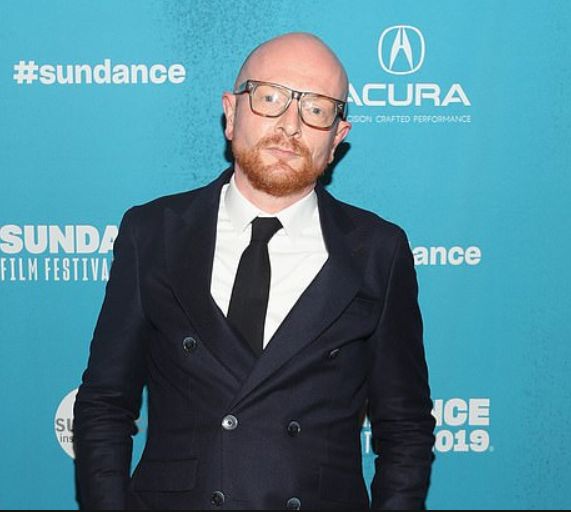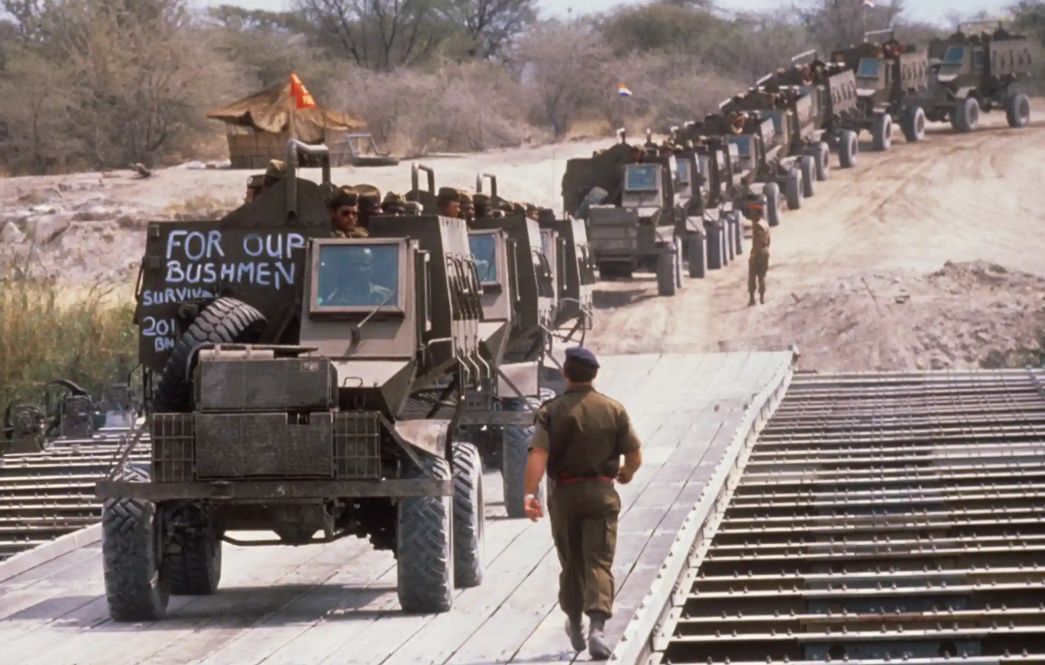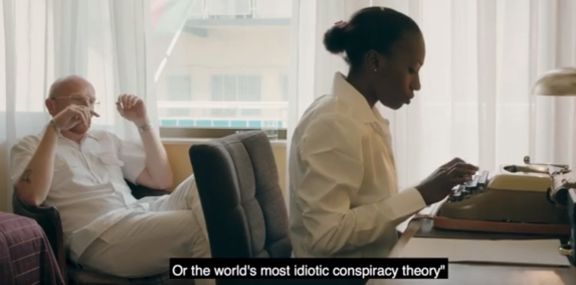Eric
Vandenbroeck 27 January 2019
Cold Case Hammarskjöld redux
In an earlier article I investigated the overblown
claims in an upcoming documentary titled Cold Case Hammarskjöld when in
reference to an at the time just-published Foreign Policy Magazine article a
person familiar with the ongoing investigations in regards to the death of
Hammarskjöld wrote to me that "the two Swedish researchers mentioned in
the June 2016 article are key persons for a documentary film currently
finalized, which even refers to Operation Celeste in its (working) title. This
nourishes some thoughts that the new prominence is given to what seems
basically old (and dubious) information based on a document with little
credibility might come opportune as a kind of promotional news for the film to
be soon released."

Above Brügger
during the 'Cold Case Hammarskjold' premiere
Currently at the Sundance
Festival, yesterday I was able to see the full version of ‘Cold Case
Hammarskjold’, whereby it is remarkable (tipped off at the time) how much
the basic scenario still is like the one
I commented on in August 2016 and as it appears to
me only the filming of certain scenes were not done yet at the time.
Initially Mads Brügger made a name for himself with The Red Chapel, in
which he posed as an experimental theater director to gain access to North
Korea. This was followed by The Ambassador, which provoked some controversial
debates over what now became seen as dubious investigative methods. The film
critic A.O. Scott, writing in New York Times wrote that Brüggers documentary might in fact be a hoax by someone who
is not be completely trustworthy.
Now Danish
provocateur Brügger returns with what sounds like a
much more conventionally structured doc but one which could be no less
shocking.
What if, Brügger asks, the 1961 death of UN Secretary-General Dag
Hammarskjöld was not the accident it has long been ruled to be but was, in
fact, an assassination? And so begins Cold Case Hammarskjöld.
Part of the
investigation, as portrayed by the documentary, is to look at how a ‘hit squad’
allegedly bombed Hammarskjöld’s plane. Whereby the investigators who are
portrayed in the film ask questions about a possible recruiting office,
apparently set up by Moise Tshombe, president of the breakaway Katanga province
of the Congo, in the Empire Building in downtown Johannesburg in 1961.
According to the Cold Case Hammarskjöld documentary, 61 mercenaries were
recruited and sent to Katanga in the spring of 1961.

Like myself,
Canadian-born author Dov Ivry doubts the claims made by Mads Brügger. In his blog Hammarskjöld
- Whodunit? Not the Guy In the Movie (Times of Israel, 14 January), charges
Brügger’s film to be "passing fiction off as
fact." He also mentions that an official report of the Belgian government
which places Van Risseghem en
route from Paris to Katanga on the night of the crash, which validates the
flight logs as written.
At a certain point,
as the clues accumulate, cancel each other out, and basically make it
impossible to follow the thread of this globetrotting whodunnit, Brügger cops to his own foibles as an investigative
journalist. Whether somewhat genuine or purely performative, his self-doubt
becomes its own kind of spectacle, as the filmmaker starts to reckon with the
idea that this may have been an enormous waste of time; it’s rare to see a
documentarian grapple with the feeling that they won’t be able to salvage a worthwhile
film from the years of footage they’ve shot along the way.
For Brügger, that crisis is further complicated by the sense
that it’s largely of his own making, that his funny, persona-driven approach
may have been too glib for a story that touches on grave and ghoulish matters
like genocide, institutionalized white supremacy, and a “doctor” who
deliberately infected black South Africans with AIDS under the guise of
offering them cheap vaccines. At the start of the film, Brügger
says that this will either be “the world’s biggest murder-mystery, or the
world’s most idiotic murder-mystery,” and there’s a moment some 90 minutes
later where it seems that he’s settled on the latter.
Not unlike before, today the makers of the
documentary have once again promoted their creation by referring to the
South African Institute for Maritime Research (SAIMR), whose self-declared
“commodore” liked to dress up on special occasions in the garish costume of a
18th-century admiral, with a three-cornered hat, brass buttons and a cutlass.
As is typical for similar outfits (in this case basically a small treasure hunting
club) a retrospective history is concocted in the hope to lift it out of
mediocrity so that it will attract members.
The documentary then
includes two dubious interviews, one with a certain Alexander Jones and the
latter a hair say claim that Van Risseghem would have
downed the plane. Here Dov Ivry added: He did not specify how much either of
them had been drinking at the times. Not to mention that obviously faced with a
dilemma by presenting two entirely different scenario's without providing even
a shred of evidence in a desperate attempt to somehow tie Van Risseghem to SAIMR in a clumsy fashion suggest that
'command could have come through an intermediary'.
The independent Hammarskjöld
Commission (para 13.42) mentions a Beukels as the
pilot. Others who have either claimed to have been responsible or who have been
accused include Bud Culligan, Colin Cooper and Swanepoel, and André Gilson.
Brügger, in a movy segment labeled
“a moment of total honesty,” admits that the Hammarskjöld question wasn’t all
that interesting to him per se, really serving a way for Brügger
to do the things he already enjoys doing.

The investigation
wasn’t getting where he wanted, and he was spinning his wheels while
interviewing “dozens of elderly white men with liver spots.” He was groping for inspiration, Brügger admits, before saying that what he found was way
worse than what he could have foreseen. The light role-playing (Brügger leaning into the unavoidable net-colonialness of his presence by bringing pith helmets along
to a dig of the plane’s wreckage) and distancing devices (animation,
self-conscious delay of the big reveal) of the first half end; the game stopped
being fun, and for the first time Brügger seems
unable to maintain some degree of remove.
Contrary to the
articles in The Guardian (UK) and an Observer
article that also was written with the assistance of the documentary’s
co-producer Andreas Rocksen and its director Mads Brügger the New York Times refused such collaboration
indicating that they perceived the claims in Cold Case Hammarskjöld as a
suspect. The NYT specifically cites here the claims made by Mr.Jones
the alleged former member of SAIMR.
As the interviews
progressed so the NYT observed, the filmmakers posed additional questions that
introduced details of possible militia activities. Thereby Mr. Jones’s
responses evolved and, by the time he sat for the final interview, he professed
firsthand knowledge of people and events that he had previously seemed to first
learn about from the filmmakers.
The filmmakers
provided the materials to the NYT, and offered a reporting collaboration. The
Times investigated the claims but did not enter into such a partnership. When
asked about the discrepancies in Mr. Jones’s story, the filmmakers acknowledged
that they could not corroborate the account and that the plan Mr. Jones had
described might not have been medically possible. They encouraged journalists
to investigate further; “and to remind readers that, even if proven true, there
is no reason to turn away from modern medical clinics, which are regulated in
ways which did not exist in the 1980s at the end of the apartheid era.” Such a
cautionary note was not included in the version of the film seen so NYT writes.
The Times then
proceeds with: An eccentric figure who insisted on the title “commodore,” Mr.
Maxwell’s writings were rambling, fantastical affairs. “He was a bit of a
clown, but he took himself quite seriously,” said Adrian Hadland, who
interviewed Mr. Maxwell in the late 1980s for the satirical magazine The
Laughing Stock. Mr. Hadland, now a professor at the University of Stirling in
Scotland, cautioned against taking any of Mr. Maxwell’s claims at face value.
“I would be very careful about putting things on the line for anything to do
with this guy,” he said.
According to the NYT
experts fear this latest conspiracy theory will erode an already weakened trust
in south African medical professionals, especially with disproportionately high
infection rates among black populations in sub-Saharan Africa.
"One dangerous
consequence of these allegations is that they have the potential to sow mistrust
and suspicion of doctors and the medical establishment, and that they may
confuse people about how HIV is transmitted," said Rebecca Hodes, the
University of Cape Town's director of AIDS and Society Research, to the Times.
Several other
comments to the NYT article where along the lines of;
"The casually
disregarded consequence of Brugger's film is to further sow seeds of doubt and
wariness about quote-unquote Western medicine in populations at risk. This is
just another don't-trust-the-West's-medicine conspiracy. The difference is that
in Brugger's film, the conspiracy is ginned up by a Westerner to entertain
white, Western audiences with audacious claims in service of a hoax."
And that; "HIV
as an agent of biological warfare does not make sense. The time from infection
to disease, even in the era before treatment, is too long on average, to suit
the needs of the shorter strategic time frame for a biologic agent."
Another reviewer
wrote: My initial experience of watching “Cold Case” was of falling into the
seductive quicksand that a conspiracy theory can create. When I saw the movie,
I bought the claims Brügger was making.
Indeed, a positive
side about Brügger's piece of art (for that of course
it is) is that it brought what otherwise is a somewhat obscure subject into the
public eye where it can be discussed.
Finally a Belgian
newspaper today published declassified documents related to Jan Van Risseghem. From the documents, it is not clear however if
Van Risseghem was even in Katanga on the date
Hammarskjöld's plane was downed.
Unwittingly the
article also reveals what strengthens my own impression and that I have serious
doubts regarding Jan Van Risseghem’s capabilities as
a fighter pilot.
So we have to look
elsewhere, whereby the likelihood is that the order to kill Hammarskjöld was
given by Katangese hardliners to prevent an agreement with the UN which may
have had led to an end of the Katangese secession, possibly without a pardon
for the punishable crimes committed by the hardliners during the secession.
It is expected that
Mohamed Chande Othman a prominent jurist who in March 2018 was
reappointed to continue his work in relation to the investigation into the
death of Hammarskjöld by June 2019 is expected to submit what might be a final
report. Asking a person who is close to the investigation about the lack of
cooperation that was experienced with the British and the South African
archives I was told that other archives may hold important information as well
so that the problems might still be manageable.
Update 7 Feb. 2019: Today Cold Case Hammarskjöld premiered in Danish
cinemas. But reviewers there were less kind than most of the American reviewers
before.
Lasse Skou Andersen
writes: Mads Brügger's new documentary "Cold
Case Hammarskjöld" is irresponsible journalism.
From a journalistic
point of view, "Cold Case Hammarskjöld" is, at best, unfinished. At
worst, the film is pure conspiracy theory.
"The temptations
for, or the pressure to close an eye for, the part of the research that doesn't
quite fit the story can be great," as DR's former director-general,
Christian S. Nissen, put it.
"Especially if
you are faced with a sensation of a solo story giving the fare of a Cavling
prize or wanting to clear the newspaper cover pages."
And movie director
Christian Monggaard writes: I
feel cheated by Mads Brügger and his "Cold Case
Hammarskjöld."
For
updates click homepage here